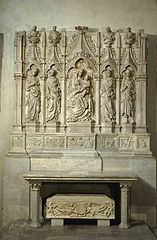Died Lucca, Italy | ||
 | ||
Children Saint Walpurga, Willibald, Winibald Similar Willibald, Saint Walpurga, Winibald, Cerdic of Wessex | ||
Saint Richard the Pilgrim (also known as St. Richard of Wessex, St. Richard the King, St. Richard the Saxon, St. Richard of Swabia) is a saint of the Roman Catholic and Eastern Orthodox Churches.
Contents
Family members
It is believed that Saint Richard was born in Wessex, England and his real name is uncertain. He was the brother-in-law of Saint Boniface (Archbishop of Mainz) and father of Saint Willibald (Bishop of Eichstätt), Saint Winnebald or Winibald (Abbot of Heidenheim) and Saint Walburga (Abbess of Heidenheim). Richard is depicted with Wuna, who is reputed to have been his wife and their three children at St. Walburga's shrine in Eichstätt.
Richard is said to have aided his gravely ill three-year-old son, Willibald, to recover through prayer.
History
Richard renounced his royal estate and set sail with his two sons from Hamblehaven near Southampton circa 721 A.D. They landed in France and temporarily stayed in Rouen. From there, they set off on the pilgrimage route to Italy, where they prayed at shrines situated along the way.
He died unexpectedly after developing a fever in Lucca, Tuscany, where he was buried in the Church of San Frediano (founded by the Irish monk Frigidian). Miracles were reported to have occurred by his tomb and a veneration cult emerged. The people of Lucca embellished their accounts of his life, describing him as an English prince. Another apocryphal story described him as the Duke of Swabia in Germany.
Richard's niece, a nun called Hugeburc or Huneburc (Huneburc of Heidenheim), wrote an account of the pilgrimage, entitled "Hodoeporicon", which Willibald, his son, continued during his journey to the Holy Land. Historians date the text between 761 and 786.
Some of Richard's relics were transported to Eichstätt, where Willibald eventually became Bishop.
In religious artworks, Richard is portrayed as a royal pilgrim in an ermine-lined cloak with two sons, one a bishop and one an abbot. His crown appears to lie on a book (Roeder). Richard is particularly venerated at Heidenheim and Lucca (Roeder). A modern icon at the Monastery of the Holy Transfiguration in the United States depicts him as King of Wessex.
The reigning king of the West Saxons or Wessex during this period was King Ine, who ascended the throne in 688 and died in or possibly after 726. Bede states that he abdicated after 37 years, i.e. 725-26. The Anglo-Saxon Chronicle refers to him abdicating in and around 726-28, then traveling to Rome and dying there. (Handbook of British Chronology, ed. Fryde et al., 3rd ed., RHS, 1986, p. 22).
Richard's feast day is 7 February.
St. Richard the Pilgrim should not be confused with Richard le Pèlerin, (also "Richard the Pilgrim"), a North French or Flemish jongleur who witnessed the siege of Antioch in 1097 and wrote a poem on the subject.
